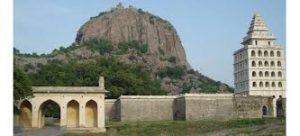Gingee Fort Has Been Nominated For UNESCO’s World Heritage Site list:

The Gingee Fort in Tamil Nadu’s Villupuram district has been nominated for UNESCO’s World Heritage Site list as part of the Maratha Military Landscapes proposal, which includes 11 other forts.
- Gingee Fort is renowned for its historical importance and strategic location atop three hillocks: Rajagiri, Krishnagiri, and Chandragiri.
- It is also known as the “Troy of the East,” as it is one of the most impregnable fortresses in peninsular India.
- Its strategic location and robust defences, including a 60-foot-wide rampart and an 80-foot-wide moat, made it vital during the Carnatic Wars between the French and British.
- The fort was originally built by Ananta Kon of the Konar Dynasty in 1200 CE and named it Krishnagiri.
- Vijayanagar Empire undertook significant renovations of the fort.
- In 1677, the fort was captured by Chhatrapati Shivaji and remained under Maratha control until 1698, when it fell to the Mughals.
- The Fort became the last stronghold for the Marathas (Rajaram I, son of Shivaji) during their resistance against the Mughal forces.
- Briefly ruled by Raja Desingh (Tej Singh), it was taken over by the Nawabs of Arcot in 1714 and remained under their dominion until 1749.
- From 1750 to 1770, the French held the fort before it eventually passed into Britishers.




